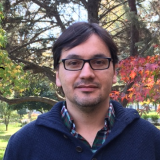The extensive kelp forests along Chile’s coastline are an important source of income for many small fishing operations in Chile. But harvesting pressure has denuded many areas of the sea floor, threatening the health of the inshore marine environment. Recently, small operators have begun work to repopulate and/or cultivate seaweed. This work aims at studying the role of fishing and agriculture as outside options and their interactions with risk and time preferences in the uptake of seaweed aquaculture technology. We use a fractional response model and data from two regions with algae aquaculture potential in Chile to model the share of area devoted to algae aquaculture activities. We find that a larger proportion of area is devoted to algae aquaculture by more experienced producers and in areas with higher suitability, less exposed to robbery, and not claimed by native communities. We also find that more risk-averse producers are more likely to adopt aquaculture. Among farmers, less risk-averse and more patient producers devote a larger area to aquaculture. The latter suggests that agriculture can be seen as a substitute activity to aquaculture. Therefore, government must develop differentiated incentives for farmers and non-farmers to encourage aquaculture.
Transition Patterns of Fishermen and Farmers into Seaweed Small-Scale Aquaculture: The Role of Risk and Time Preferences 20-03
Country
Sustainable Development Goals
Publication reference
Cesar Salazar, Marcela Jaime, and Miguel Quiroga; 2020, Transition Patterns of Fishermen and Farmers into Seaweed Small-Scale Aquaculture: The Role of Risk and Time Preferences, EfD Discussion Paper Series 03-20


